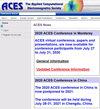Design of W-band PIN Diode SPDT Switch with Low Loss
IF 0.6
4区 计算机科学
Q4 ENGINEERING, ELECTRICAL & ELECTRONIC
Applied Computational Electromagnetics Society Journal
Pub Date : 2021-01-01
DOI:10.47037/2021.aces.j.360712
引用次数: 2
Abstract
A W-band PIN diode single pole double throw (SPDT) switch with low insertion loss (IL) was successfully developed using a hybrid integration circuit (HIC) of microstrip and coplanar waveguide (CPW) in this paper. In order to achieve low loss of the SPDT switch, the beam-lead PIN diode 3D simulation model was accurately established in Ansys High Frequency Structure Simulator (HFSS) and the W-band H-plane waveguide-microstrip transition was realized based on the principle of the magnetic field coupling. The key of the proposed method is to design the H-plane waveguide-microstrip transition, it not only realizes the low IL of the SPDT switch, but also the direct current (DC) bias of the PIN diode can be better grounded. In order to validate the proposed design method, a W-band PIN diode SPDT switch is fabricated and measured. The measurement results show that the IL of the SPDT switch is less than 2 dB in the frequency range of 85 to 95 GHz, while the isolation of the SPDT switch is greater than 15 dB in the frequency range of 89.5 to 94 GHz. In the frequency range of 92 to 93 GHz, the IL of the SPDT switch is less than 1.65 dB, and its isolation is higher than 22 dB. Switch rise time and switch fall time of the SPDT switch are smaller than 29ns and 19ns, respectively. Good agreement between the simulations and measurements validates the design method.低损耗w波段PIN二极管SPDT开关的设计
本文利用微带和共面波导混合集成电路成功研制了一种低插入损耗的w波段PIN二极管单极双掷开关。为了实现SPDT开关的低损耗,在Ansys High Frequency Structure Simulator (HFSS)中精确建立了引束PIN二极管三维仿真模型,并基于磁场耦合原理实现了w波段h面波导-微带跃迁。该方法的关键是设计h面波导-微带过渡,不仅实现了SPDT开关的低IL,而且可以更好地接地PIN二极管的直流偏置。为了验证所提出的设计方法,制作了一个w波段PIN二极管SPDT开关并进行了测量。测量结果表明,SPDT开关在85 ~ 95 GHz频率范围内的隔离度小于2 dB,而在89.5 ~ 94 GHz频率范围内的隔离度大于15 dB。在92 ~ 93 GHz频率范围内,SPDT开关的IL小于1.65 dB,隔离度高于22 dB。SPDT开关的上升时间小于29ns,下降时间小于19ns。仿真结果与实测结果吻合良好,验证了设计方法的有效性。
本文章由计算机程序翻译,如有差异,请以英文原文为准。
求助全文
约1分钟内获得全文
求助全文
来源期刊
CiteScore
1.60
自引率
28.60%
发文量
75
审稿时长
9 months
期刊介绍:
The ACES Journal is devoted to the exchange of information in computational electromagnetics, to the advancement of the state of the art, and to the promotion of related technical activities. A primary objective of the information exchange is the elimination of the need to "re-invent the wheel" to solve a previously solved computational problem in electrical engineering, physics, or related fields of study.
The ACES Journal welcomes original, previously unpublished papers, relating to applied computational electromagnetics. All papers are refereed.
A unique feature of ACES Journal is the publication of unsuccessful efforts in applied computational electromagnetics. Publication of such material provides a means to discuss problem areas in electromagnetic modeling. Manuscripts representing an unsuccessful application or negative result in computational electromagnetics is considered for publication only if a reasonable expectation of success (and a reasonable effort) are reflected.
The technical activities promoted by this publication include code validation, performance analysis, and input/output standardization; code or technique optimization and error minimization; innovations in solution technique or in data input/output; identification of new applications for electromagnetics modeling codes and techniques; integration of computational electromagnetics techniques with new computer architectures; and correlation of computational parameters with physical mechanisms.

 求助内容:
求助内容: 应助结果提醒方式:
应助结果提醒方式:


